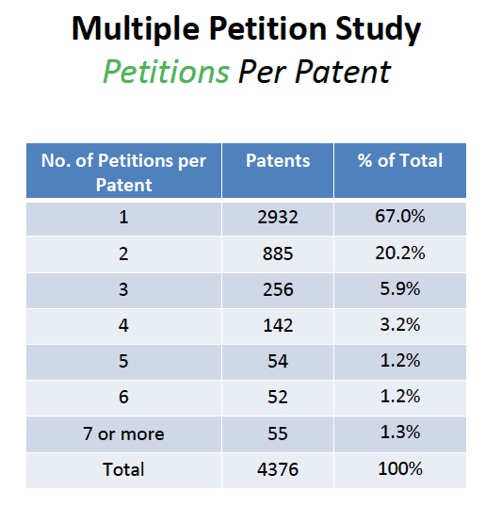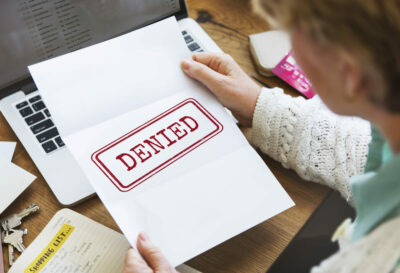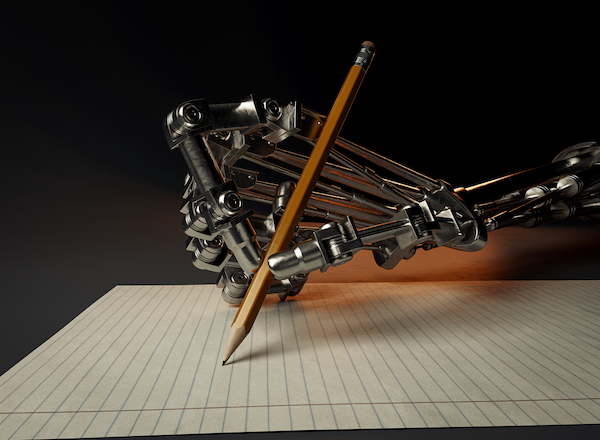87.2% of patents in the study, per the table, were subjected to just 1 or 2 IPR petitions – so gang tackling is no big deal. But make this simple observation: If a patent is killed in its first IPR, it can’t possibly be considered for a second one.

Image Source: Deposit Photos.
I had the opportunity recently to see Chief Judge David Ruschke speak at the IPBC Conference in San Francisco. He went through a recent analysis prepared by the USPTO on the issue of “Multiple Petitions.” The people on the receiving end of this PTAB strategy usually refer to it as Gang Tackling. I want to commend the USPTO for doing the analysis to see if there is in fact an actual problem and the Judge personally for making the effort to explain their conclusions.
Judge Ruschke’s overall conclusion is that the issue of gang tackling has been portrayed as more serious than the data would justify. With due respect, I’d suggest this conclusion stems from a foundational misunderstanding of how the statistics should actually be construed. Take a look at the USPTO’s table below.
87.2% of patents in the study, per the table, were subjected to just 1 or 2 IPR petitions – so gang tackling is no big deal. But make this simple observation: If a patent is killed in its first IPR, it can’t possibly be considered for a second one.
The USPTO keeps their denominator fixed (and too large), which artificially lessens the reported percentage of patents which have large numbers of petitions filed against them. The calculation shouldn’t be 55/4,376 = 1.3% because by the time a patent faces its 7th(!) IPR petition, the universe of eligible-for-challenge patents is much smaller than during the first petition.
Or asked another way, “How many patents which survive their first IPR are subsequently left alone? How many are subjected to yet another IPR?” Worse still, “How many patents are IPR’d to death rather than ever being granted quiet title?”
The study doesn’t include sufficiently granular data to answer the question with certainty, but here’s simple math. Start with 1,000 patents. Then ask the patent owner to run a gauntlet where she has a 60% survival rate. Do it once, and 600 patents remain. Run it six times, and she’s down to 47 patents. From 1,000. Patent owners would no doubt like to see the published statistics that tell them how many IPRs they have to survive before their asset is no longer in jeopardy.
This isn’t the first time that USPTO statistics have been called out as misleading. And as before, I don’t want to imply nefarious intent. But Director Iancu has indicated that new policies, including on institution practices, are coming this summer, and it’s critically important that real-world experience – not just statistics – guides those decisions.
The nice thing about statistics is if you tell me whatever result you want, I can give you solid numbers. Remember the wise owl getting to the center of a Tootsie Pop!?! Instead, step back for a moment and ask policy questions about gang tackling:
- Do we or don’t we want quiet title so patent owners definitively know what rights they have? And technology implementers can design around them?
- Is it an efficient use of USPTO resources to continue revisiting the same patent?
- Do we want IPRs’ page limit constraints to be actually enforced limits or simply a price-per-challenge that deep-pocketed companies can simply pay their way around?
As presently configured, the IPR process is reminiscent of the old IRA adage that Thatcher had to be lucky every day, and they only had to get lucky once. Our Patent Office’s leadership can do better than this, and I expect they will. By all means fix mistakes, but let’s not lose sight of the fact that the Patent Office exists to encourage invention and protect inventors.

![[IPWatchdog Logo]](https://ipwatchdog.com/wp-content/themes/IPWatchdog%20-%202023/assets/images/temp/logo-small@2x.png)


![[Advertisement]](https://ipwatchdog.com/wp-content/uploads/2024/04/Patent-Litigation-Masters-2024-sidebar-700x500-1.jpg)

![[Advertisement]](https://ipwatchdog.com/wp-content/uploads/2021/12/WEBINAR-336-x-280-px.png)
![[Advertisement]](https://ipwatchdog.com/wp-content/uploads/2021/12/2021-Patent-Practice-on-Demand-recorded-Feb-2021-336-x-280.jpg)
![[Advertisement]](https://ipwatchdog.com/wp-content/uploads/2021/12/Ad-4-The-Invent-Patent-System™.png)






Join the Discussion
30 comments so far.
Disenfranchised Patent Owner
July 4, 2018 11:34 amIf a standard lower than “clear and convincing evidence” is used for instituting IPR, then the process has devolved into one based on “more likely than not” that a panel of biased kangaroos can be persuaded to find something possibly could be “proven” obvious to a hypothetical person of ordinary skill in the art at the time of the invention with reasonable expectation of success.
That’s not exactly “title,” is it? Certainly not “quiet” title. The new US patent cover states:
“Therefore, this United States Patent grants to the person(s) having title to this patent the right to exclude others from making, using, offering for sale, or selling the invention throughout the United States of America or importing the invention into the United States of America…”
The only “right” being granted “to the person(s) having title” is an obligation to try to defend the patent being granted against being extinguished in costly, biased IPR’s instituted upon a highly subjective “more likely than not” determination, conducted by the same panel of kangaroos who decide the patent’s fate, and whose continued employment is directly impacted.
I think I’d rather pay to play a game of Russian roulette…
Night Writer
July 2, 2018 08:13 am@25 Paul: “Would not a legislative proposal requiring ‘clear and convincing evidence’ for an IPR seem both fairer and more palateable than that?”
I agree with this and this is what I said above too. I think this would fix most of the problems and if the judges were made ALJs then it would all probably be fine.
The point, though, of multiple IPRs is that they are instituted not usually with “new” art, but with the same art or cumulative art. The point is that with KSR any claim can be found to be obvious over the prior art. So the way it is now each IPR is essentially a roll of the dice if you get a panel that decides to invalidate your claims on what is most likely about the same art that your patent was allowed over.
Anon
June 28, 2018 08:40 amMr Martillo @ 26,
I understand perfectly well what you are trying to say – your application of math is simply not correct, given how the issue of 102/103 is in fact dependent on the specific art brought forward.
Your fixation on the “math” of likelihood is crabbed, and you incorrectly assign likelihood at too gross of a level, ignoring what the law actually provides, and that any one challenge under 102 or 103 is necessarily tied NOT (only) to the statutory basis, but ALSO to the specific art under that statutory basis.
Read again my reply. It is on point and reminds you of the fact that a court – for the reason provided – does NOT declare a patent proved valid.
Your attempt to equate any and all 102/103 arguments based ONLY on the statutory ground is just not valid. You simply cannot sweep away ANY first 102/103 challenge as you attempt to do (unless that first challenge includes ALL possible art in its challenge – which is just not EVER the case). To this point then, your reply to Mr. Morgan @ 27 incorrectly labels his post as a pure straw man. Whether or not this is the age of the World Wide Web, the choice to challenge is not constrained as you wish it to be. Does this permit “gang tackling” as you suppose? Yes, yes it does. But that IS how the law is written. Wanting the law to be something else is not “bad” or “wrong” in and of itself. Deluding yourself with a faulty math premise in order to think that the current law is something other than what it is – THAT is “bad” and “wrong.” Your logic is faulty – as I have provided to you.
Joachim Martillo
June 28, 2018 03:57 amPaul Morgan @ 25 June 27, 2018 7:41 pm,
You are pointing out why I stated that institution (and not petition) should be a one shot.
If the prior art (35 USC § 102, 35 USC § 103) is poor, the PTAB should not institute, and the situation that you propose is pure straw man.
Joachim Martillo
June 28, 2018 03:47 amAnon@21 June 27, 2018 12:06 pm,
You may misunderstand my comment.
Neither 28 U.S. Code § 2201 – Creation of remedy
nor 35 U.S. Code § 271 – Infringement of patent
imposes a mathematical test or statistical/probabilistic estimation for filing a complaint for a civil action in federal court.
Yet,
35 U.S. Code § 314 – Institution of inter partes review
and
35 U.S. Code § 324 – Institution of post-grant review
explicitly impose a mathematical test or statistical/probabilistic estimation (“likelihood”/”likely”) for institution.
Respectively:
(a)Threshold.—
The Director may not authorize an inter partes review to be instituted unless the Director determines that the information presented in the petition filed under section 311 and any response filed under section 313 shows that there is a reasonable likelihood that the petitioner would prevail with respect to at least 1 of the claims challenged in the petition.
And
(a)Threshold.—
The Director may not authorize a post-grant review to be instituted unless the Director determines that the information presented in the petition filed under section 321, if such information is not rebutted, would demonstrate that it is more likely than not that at least 1 of the claims challenged in the petition is unpatentable.
———————————–
I am pointing out an important technical issue that the PTAB is addressing incorrectly or is not addressing at all.
P(A) means probability of A.
P(A|B) means the probability of A under the condition of B.
P(new petitioner prevailing on given statutory challenge | patent owner already prevailed on same statutory challenge previously) < P(another petitioner prevailing on same statutory challenge previously)
In other words, the rules for proceeding with a new litigation at the PTAB are according to statute (35 USC § 314 or 35 USC § 324) very different from the rules for proceeding with a new litigation at federal district court. I have not read a decision for institution that describes the reasoning of the PTAB with respect to this fundamental difference.
I can only conclude that the PTAB is currently improperly instituting the 2nd time that a petition for institution is made on a given statutory ground.
The PTAB should explicitly address the issue of conditional likelihoods in situations of multiple challenges on a single statutory grounds, and for purposes of judicial efficiency, petitioners and the patent owner should be compelled to motion for joinder under the following rules if multiple IPRs or PGRs are instituted against one patent owner:
37 CFR § 42.122 Multiple proceedings and Joinder
and
37 CFR § 42.222 Multiple proceedings and Joinder.
It’s the age of the world wide web. It is easy for petitioners to do searches and to work together. If petitioners are gang-tackling, the Office should — unless there is strong evidence to the contrary — assume that petitioners are gaming the system in order to grind down the patent owner.
In other words, on a specific statutory ground (35 USC § 101, 35 USC § 102, 35 USC § 103, & 35 § 112), we should almost never see multiple institutions. If we a seeing too many instances of gang-tacking, we are seeing either gaming among petitioners or corruption at the PTAB or both.
The Office should be allowing almost no or no instances of multiple institution. This discouraging of multiple institution should be no burden and will improve judicial efficiency immensely while petitioners are still able to avail themselves either of requests for ex parte reexamination or of proceedings in federal district court.
A RELATED MATTER
It’s not a matter of judicial efficiency, but it is a matter of basic fairness. The statutes governing institution of IPR and PGR should be rewritten to state explicitly that the petitioner bears all cost of the proceedings (explicitly including attorney fees in order to overcome the American rule, which in any case may not apply in administrative proceedings). Petitioner should be required to provide a bond to cover expected costs art during petition. If the petitioner fails to provide a bond, institution should be denied.
Once institution is allowed, the petitioner wins in all cases. He should pay for his win because the patent owner already in good faith spent a lot of money on the issuance of a patent, and the cancellation of claims is of immense financial benefit to all who want to use the technology of the letters patent without paying for that use. An efficient infringer benefits from a final written decision of patentability because an infringer can point to institution of IPR or of PGR in defending against a charge of willful infringement (35 U.S. Code § 284 – Damages).
Paul Morgan
June 27, 2018 07:41 pmNW, what AIA legislative change are you proposing? If it is to allow only one IPR petition against each patent, no matter how many different defendants are sued on that patent, it would invite initial weak straw man IPRs to block all suit defendent IPRs with more effective, better prior art, IPR petitions. Wouldn’t suit defendants argue unequal treatment and lack due process against that kind of legislative change being enacted? Would not a legislative proposal requiring “clear and convincing evidence” for an IPR seem both fairer and more palateable than that?
Joachim Martillo
June 27, 2018 12:52 pmAaric Eisenstein asks the following.
Because I am Darth Grammaticus, I have to point out that he really means the following.
Night Writer
June 27, 2018 12:46 pm>>The weird thing is the infringer lobby is very happy with 60-70% “defect rates”. They will pitch fits if the institution rate drops to 10% (which is still 40X higher than a 3-sigma quality operation).
Any change that strengthens patents is going to be fought tooth and nail. There is lots of money and K Street is behind them.
Night Writer
June 27, 2018 12:44 pm@20 Josh
I agree. It is a fantastic idea!!!!!!!!!!!!!
Anon
June 27, 2018 12:06 pmJoachim @17,
Your statement of “and likelihoods of a petitioner’s prevailing must shift significantly for a future challenge on a given statutory basis once a patent owner has prevailed in a challenge on the same statutory basis.”
is not correct.
It is simply not a matter of “same statutory basis” – per se.
For example, the two statutory basis of 35 USC 102 and 35 USC 103 (of which, IPR is limited to, unlike other PGR mechanisms), are MORE dependent on the specific art brought along and with the statutory basis.
This is precisely why an Article III court does not say “proved valid,” but instead says, “not proved invalid.”
Thus, “It should make no difference that a challenger has found new prior art for a § 102 or § 103 challenge.” is absolutely incorrect.
Thus, “In other words the statutes mathematically require institution to be a one-shot by statutory ground.” is absolutely incorrect – in direct relation to 102 and 103.
Josh @20, If I may, let me tweak your statement of “– finally makes sense of the procedures and burden shifting that remove the presumption of validity“:
By instituting a requirement of clear and convincing AT the institution decision point (AND maintaining this requirement throughout the process), the statutory presumption of validity is maintained properly, thus avoiding an impermissible Takings of one of the sticks in the (Franchise // Personal) Property right.
Josh Malone
June 27, 2018 10:46 amClear and convincing on institution. This is a fantastic proposal.
– consistent with the intent to correct errors and eliminate fix “bad patents”
– shows the PTO stands by its work product
– restores stability and predictability to issued patents
– institution rate approaches OPQA defect rate (6-8%)
– fully within the discretion of the agency/Director
– finally makes sense of the procedures and burden shifting that remove the presumption of validity – if a clear error is shown it now makes sense that the PO has to prove up his case for patentability
The weird thing is the infringer lobby is very happy with 60-70% “defect rates”. They will pitch fits if the institution rate drops to 10% (which is still 40X higher than a 3-sigma quality operation).
Disenfranchised Patent Owner
June 27, 2018 09:01 amNight, I agree…
Why should the standard for instituting review in an expedited, shortcut IPR procedure be lower than the clear and convincing standard used in the courts?
The AIA itself is a huge mistake! It needs to be fixed.
Anon
June 27, 2018 08:53 amNight Writer @ 15,
You are aware of course that the IPRs in the AIA were sold on the premise that the institution barrier had been raised, right?
Joachim Martillo
June 27, 2018 07:42 amAre you guys responding to USPTO Announces Notice of Proposed Rulemaking for Claim Construction Standard used in PTAB Proceedings.
The web page states the following.
If judicial efficiency is a goal, a Bayesian model of learning from experience should be applied, and likelihoods of a petitioner’s prevailing must shift significantly for a future challenge on a given statutory basis once a patent owner has prevailed in a challenge on the same statutory basis.
A second post-grant review proceed (IPR or PGR) should never be instituted if the challenge is based on the same statute that was the basis of a previous challenge in which the patent owner prevailed.
It should make no difference that a challenger has found new prior art for a § 102 or § 103 challenge.
In other words the statutes mathematically require institution to be a one-shot by statutory ground.
Applying this logic increases judicial efficiency
1) because repeat challenges are not allowed and
2) because petitioners are incentivized to petition as early as possible and to combine multiple challenges on a single statutory basis into a single challenge.
I try to make this point in my response.
Night Writer
June 27, 2018 06:12 am@11 The basic premise of IPRs is to fix mistakes
That points to a way to help the problem. Maybe rather than more likely than not change the standard for instituting an IPR to clear error.
Night Writer
June 27, 2018 06:10 am@ Paul Morgan
>>There is no constitutional way to prevent each defendant from independenly re-challenging patent validity if it has new evidence.
Yes there is. Just change the AIA law. What Constitutional provision do you think it would implicate?
Just Curious
June 26, 2018 09:44 pm1. This article implies that some petitioners file multiple petitions to get around the page limit. How many of those second petitions are from the same petitioner versus other petitioners?
2. According to https://www.uspto.gov/patents-application-process/patent-trial-and-appeal-board/statistics less than 1/4 of petitions reach a final written decision. Many are not instituted or joined with other petitions, which saves the patent owner money. What would the stats look like if you count patents with multiple final written decisions instead of simply counting patents with multiple petitions?
3. What would the stats look like if you include a row for patents asserted with 0 IPR petitions?
Night Writer
June 26, 2018 06:51 pmFundamentally the problem too is based on a false premise that somehow the PTO can fix its errors in some abbreviated procedures that don’t give all the procedural protections to the patent owner.
Frankly, though, now that we are just a public right and anything goes, there is very little chance of patents ever being fixed.
Josh Malone
June 26, 2018 05:18 pmHere is a little more color to this discussion about serial IPR’s and quiet title. Imagine that CBM is allowed to sunset. Imagine further that IPR’s are repealed completely. The only thing left is PGR within 9 months of issuance. PTAB apologists recoil in horror at this thought. Stronger Patents Act is extreme, but this is insane!
This “extreme” proposal does not touch my case. $20M in legal costs, 4.5 years of patent term, 6 patents, 8 PGRs. Not a single day of market exclusivity. With only PGR.
We cannot allow the debate to be about serial IPR’s, BRI, and amendments. The debate we must have is whether the USPTO is going to defend patents or destroy patents. Seems pretty straightforward.
Aaric Eisenstein
June 26, 2018 01:37 pmThe basic premise of IPRs is to fix mistakes. A given patent shouldn’t have ever issued, and the IPR is a way to point that out. As a policy matter, it seems that at some point – after x IPRs or y other-post-grant-reviews or etc. – the PTO should say that they’re internally comfortable that they’ve looked at a particular patent enough that the patent owner should have quiet title.
District Court is different. An infringement suit is an “accusation” against a specific entity. Someone accused of infringement should be allowed to mount whatever defense they can, from invalidity to non-infringement. Estoppel should be in place so that the court isn’t wasting its own resources relitigating a settled issue.
The problem, as Director Iancu has pointed out, is that IPRs and litigation are being used essentially interchangeably, typically serially. Instead, the government should say that at some point, the patent owner should be able to rely on his grant, and someone accused of infringement should always have the ability to defend himself. It does appear that the Patent Office is taking steps in that direction, and it’s a good thing. Other agencies across government issue final decisions routinely, and then it’s up to the courts to decide if a specific instance needs addressing. The same process needs to happen with patents.
Anon
June 26, 2018 11:32 am“shows they have taken the heat on this issue seriously”
How difficult it must be for the person who has constantly derided all criticism of the PTAB and the IPR regime to – even if only in passing – reflect that providing such heat had been fruitful.
Alas, little suffice there, as the pom-poms come right back out.
Paul Morgan
June 26, 2018 09:51 amThe PTAB has recently been taking some effective steps to deny more subsequent IPR petitions on the same patent ab initio. This very PTAB analysis shows they have taken the heat on this issue seriously. But even the above-suggested number calcuation is still not correct, because these numbers are the number of petitions FILED, not even the number of petitions actually initiated, not the number granted and fully decided.
Also, how may of these patents with plural petitions were due to suing plural different defendants? There is no constitutional way to prevent each defendant from independenly re-challenging patent validity if it has new evidence.
Disenfranchised Patent Owner
June 26, 2018 08:48 amNight Writer,
Well said: “The bottom line is that your claims just aren’t worth much…” courtesy of the AIA’s out-of-control PTAB death squad, and the CAFC slinging out its Rule 36 non-opinion rulings which effectively cannot be appealed.
Joanne
June 26, 2018 12:42 amDavid Ruschke? Does he still have credibility after suing a major stakeholder while sitting as Chief Judge? Why is no one calling out the emperor on his magnificent outfit?
https://www.law.com/nationallawjournal/2018/06/13/ptab-chief-accusing-former-employer-of-sexual-orientation-disability-bias/
Night Writer
June 25, 2018 10:43 pmProbably too a lot of what is happening is that there isn’t a dispute anymore. You win one IPR, but you cave and drop the licensing fees so you don’t have to try to survive another one. Etc.
I looked at one patent that had about 9 IPRs and CBMs in the patent family. Some claims survived and survived the federal court and then the CAFC invalidated them.
The bottom line is that your claims just aren’t worth much when you can be put through this to try to enforce them.
mike
June 25, 2018 04:42 pmThanks for this review and your pointing out of the essential flaw in the statistics. This could be partly cured by providing a third column on the table, the percentage of patents that had claims invalidated as an outcome of each successive petition. Chief Judge Ruschke’s complaisance only makes sense if each successive petition is much less likely to succeed than the preceding one. Otherwise, there is no such thing as a good patent.
Bemused
June 25, 2018 01:44 pmHere’s another piece of the puzzle: How many patents were subjected to ex parte reexaminations pre-AIA and were then subjected to IPRs post-AIA?
I’m personally aware of two such situations where patents survived multiple ex parte reexaminations only to have petitions for IPR granted by the PTAB ON THE EXACT SAME PRIOR ART THAT WAS SUBMITTED IN THE REEXAMINATIONS PROCESS AND WHICH HAD CLAIMS ALLOWED OVER SUCH PRIOR ART.
On a potentially positive note, I’m starting to see on the Docket Navigator more denials of petitions for IPR. Not sure if this is due to a small sample sizing anomaly or whether its a result of Director Iancu’s influence but it will be interesting to keep an eye on the institution rate.
Disenfranchised Patent Owner
June 25, 2018 01:00 pmJosh, multiple petitions simply should not be allowed. For that matter, no petitions should be allowed. Patents partially or wholly invalidated through IPR’s comprise an unconstitutional Fifth Amendment taking.
Jianqing Wu
June 25, 2018 11:17 amIPR is clearly a process design with multiple fatal flaws. The law crating this process is not to achieve justice, fairness, productivity, national competitiveness, or anything good. I found that none of the anti-patent arguments in overall litigation spending, patent troll conducts, grant mistake, etc. can justify such flawed process. We all know all legal definitions are always subject to different interpretations. If the justice compositions in the U.S.Supreme Court are changed, we would see many different absurd doctrines to bar different types of inventions. Any attempt to take away granted patents hurts the patent system and discourages future invention. Granting excessive number of patents has worked in two ways in the patent history. Some inventors try to invent because they saw how likely people can get patents. This mass taking back practice works as a negative incentive.
Invention justice is a myth. It is true that lawmakers can shut down the U.S. patent system for corporation short-term benefits. A proper way for doing so is to cancel the patent clause in the U.S. constitution, rather than using litigation spending, grant errors, burden,etc. as pretext. If that is done, everyone expects what will happen.
Josh Malone
June 25, 2018 10:07 amI see that there are 1,344 patents that have been subjected to multiple petitions (including my own). Why is that not a serious concern?